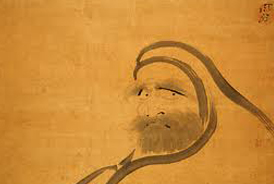by Sifu Anthony: What do Cosmos Qigong, Shaolin Kung Fu, and Zen Meditation have in common? Sure, they’re all energy arts, and they all came from the Shaolin Temple. But did you know that they also came from the same man?
If you practice any of these arts, then like me, you belong to the legacy of Bodhidharma. Today, he is recognized as the 28th Patriarch of Buddhism, the 1st Patriarch of Zen, the 1st Patriarch of Shaolin Qigong, and the 1st Patriarch of Shaolin Kung Fu. Not a bad résumé!
Bodhidharma was an Indian prince who lived in the 6th Century AD. After renouncing his royal life, he decided to travel to India in order to teach Buddhism in China. His long journey eventually brought him to the Shaolin Temple in Songshan province.
Even before Bodhidharma arrived, Buddhism was already spreading through China. (Remember that Buddhism was already 1000 years old by this time.) In 497 AD, the Chinese emperor had the Shaolin Temple built in order to promote Buddhism in his empire. By the time Bodhidharma arrived at the temple in 527 AD, there were already many monks living there.
What Bodhidharma found at the temple was disheartening. The monks were weak and sickly, they were falling asleep during meditation, and they lacked the vitality needed for deep meditation. This was not Bodhidharma’s vision of spiritual cultivation.
Bodhidharma believed that physical, intellectual, and spiritual cultivation were an indivisible whole. If you are sick or in pain, then how can you hope to achieve enlightenment? If you lack mental clarity, how will you endure the intensity of meditation? To work successfully towards enlightenment, one needs to also cultivate health, vitality, and mental clarity. This was Bodhidharma’s philosophy.
It’s clear that Bodhidharma was a powerful master, full of health, vitality, mental clarity, and internal force. We know that he learned Buddhist meditation from his teacher, Prajnatara. But where did he learn Qigong?
We can only speculate, but it is likely that Bodhidharma, a crowned prince, was well trained in elite arts befitting royalty. In addition to various scholarly arts, it’s likely that he learned ancient Indian martial arts, as well as some form of yoga. Unlike the yoga found in most gyms today, the yoga of Bodhidharma’s time was likely to be a very powerful energy art.
Bodhidharma knew that, in order to help the Shaolin Monks reach enlightenment, he would need to help them to cultivate health, vitality, and mental clarity. What Bodhidharma did next changed the course of history. Rather than teach the monks the various yoga and martial arts exercises that he had learned, he decided to develop a completely new set of exercises. For the next 9 years, he lived in a cave near the Shaolin Temple and practiced in seclusion. When he left the cave, he brought three new sets of exercises with him:
These exercises were specifically designed to prepare the monks for the rigors of Zen meditation. And they worked like a charm. The exercises transformed the monks physically, energetically, mentally, and spiritually. Over time, thanks to the success of these exercises, the Shaolin Temple became one of the most powerful spiritual centers in the history of the world.
Today, 1500 years later, Bodhidharma’s legacy is alive and well. The basic philosophy in my school is the same as Bodhidharma’s — health, vitality, and mental clarity are prerequisites for spiritual cultivation. Thus, I teach the same exercises that Bodhidharma taught. The first Qigong technique that my students learn is Lifting The Sky, which is the first of the 18 Luohan Hands. Over time, students progress to learn all 18 of the techniques, all 12 Sinew Metamorphosisexercises, and all 5 Levels of Bone Marrow Cleansing.
What about Shaolin Kung Fu? Actually, Bodhidharma never taught Shaolin Kung Fu.Then why is he widely recognized by Shaolin Kung Fu schools as the 1st Patriarch? Because the arts that Bodhidharma taught provided the foundation and the inspiration for the future development of Shaolin Kung Fu.
The 18 Luohan Hands gradually developed into the 18 Arhat Arts and Luohan Kung Fu. Over centuries, these arts developed into the many different styles of Shaolin Kung Fu. There is even a saying in China that “all martial arts come from Shaolin.” Many Japanese Karate schools trace their lineage all the way back to the Shaolin Temple.
Even Tai Chi Chuan sprouted from the legacy of Bodhidharma. The great master Zhang San Feng graduated from the Shaolin Temple in the 13th Century. He became a master of Shaolin Kung Fu, Sinew Metamorphosis, and Zen meditation. Later, he transformed these into a new art, which he called Shaolin Wudang Kung Fu. Many years later, this art would be called Tai Chi Chuan.
It’s difficult to imagine how different history would have been if Bodhidharma had stayed in India instead of traveling to China. Would we even know about the Shaolin Temple, or would it have disappeared into obscurity centuries ago? How many martial arts would be completely different without the influence of Shaolin Kung Fu? And what would the world be like without Zen?
Thankfully, Bodhidharma didn’t stay in India. In a similar way, I’m also grateful that my teacher, Grandmaster Wong, didn’t stay in Malaysia. Thankfully, he decided to travel the world in order to spread these wonderful arts. In some ways, I feel that Grandmaster Wong is a modern Bodhidharma, spreading health and vitality with the Shaolin arts. And because of that health and vitality, more and more people are able to experience the joys of spiritual cultivation.
Zenfully yours,
Sifu Anthony










































